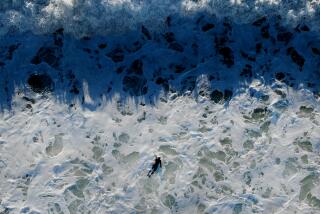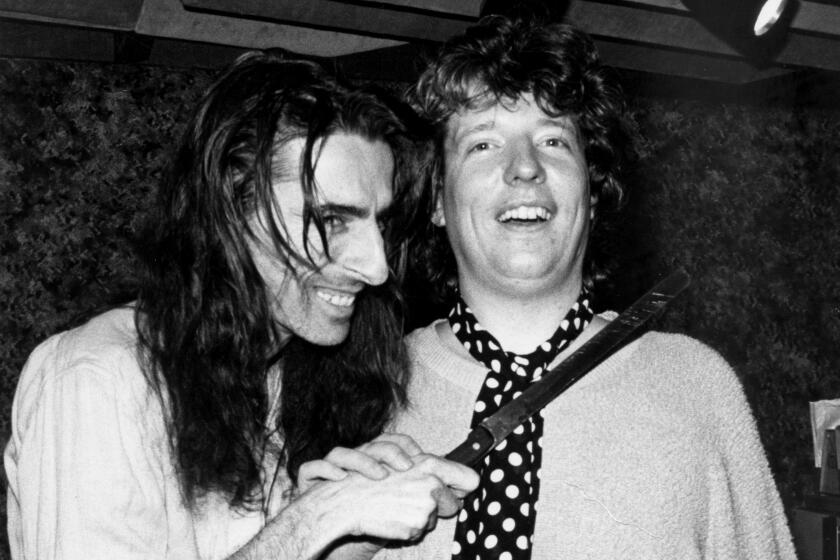Hobie Alter dies at 80; shaped Southern California surf culture
- Share via
When he was a young man, Hobie Alter had a clear vision of his future: He didn’t want a job that would require hard-soled shoes, and he didn’t want to work east of Pacific Coast Highway.
He succeeded.
The son of a second-generation orange grower, Alter is credited with innovations that allowed people who couldn’t lift log slabs to surf and those who couldn’t pay for yacht club memberships to sail.
Share your memories: Hobie’s contributions to SoCal culture
Known practically everywhere with a coastline or a lake simply as “Hobie,” Alter developed the mass-produced foam surfboard. He later popularized sailing by inventing a lightweight, high-performance catamaran.
He died Saturday at his home in Palm Desert, according to an announcement posted on https://www.hobie.com, his company’s website. He was 80. The cause of death was not disclosed.
Alter was diagnosed with cancer about five years ago and since then had experienced serious health problems, said Paul Holmes, author of “Hobie: Master of Water, Wind and Waves,” a 2013 biography.
A self-taught design innovator and entrepreneur, Alter was a reluctant businessman who wore cutoffs instead of suits and was guided by his imagination above all else.
“I’m making money producing things that give me pleasure, doing exactly what I want to do,” Alter told a reporter in 1977. “I guess I’m really lucky that way.”
There were only several hundred surfers lugging their heavy wood boards into the waters of Southern California in 1958 when Alter and then-partner Gordon “Grubby” Clark perfected the delicate chemical process of making rough-cut polyurethane foam blanks that could be custom shaped in less than an hour.
Initially dismissed as flimsy toys, Hobie’s lightweight boards caught on. In less than a year, wood boards that had been used since Hawaiians invented the sport were obsolete.
Alter’s timing couldn’t have been better. The following year, the movie “Gidget” introduced the nation to a fun-loving California subculture. Interest in the sport surged, and Alter — the so-called Henry Ford of surfing — was there to provide the vehicle.
Soon his Dana Point workshop was pumping out 250 boards a week and became the epicenter of California’s burgeoning surf culture, a place through which a generation of top shapers practiced their craft.
Photos: Alter through the years
Alter licensed the Hobie name to new surf shops in San Diego, Hawaii, Peru and on the East Coast, and sponsored a team of professional surfers, including Phil Edwards, Joey Cabell and Corky Carroll. All got their names on “signature” Hobie surfboards — another business innovation that spurred sales.
The Hobie brand dominated the surfboard business into the 1970s. Today, the foam-core board remains the standard for an industry Alter arguably helped create more than half a century ago.
“He is one of the pillars on which the sport of surfing is built upon,” said Steve Pezman, a surfing historian and publisher of the Surfer’s Journal. “He was enamored with inventing things. He’d get interested in something, see how it could be improved and go make a better version of it. Once it became repetitive, he moved on to something new.”
In the mid-1960s, with his surfboard business booming, Alter turned his restless imagination to a new hobby — sailing.
As with wooden surfboards, Alter discerned an inherent problem with his 600-pound catamaran: It took at least four people to haul it to the water. Sailing shouldn’t be that hard, he thought.
After more than a year of experimentation, Alter unveiled the Hobie Cat. The 14-foot catamaran was light enough for one person to carry and small enough to tow or even strap onto a car roof.
“He totally democratized sailing,” Holmes, Alter’s biographer, said. “Prior to the late-1960s, it had been the preserve of a pretty elite group. But then you could get a fully rigged Hobie 14 for $999 — with the trailer.”
At first dismissed as a flimsy toy by the sailing establishment, the relatively inexpensive Hobie Cat was fast, easy to maneuver and wildly popular with beginning sailors. Life Magazine featured it in a photo essay titled “The Cat That Flies.” More than 30,000 were sold in six years, according to Forbes magazine.
The original Hobie Cat and subsequent larger models did for sailing what the foam-core board had done for surfing: made a niche sport accessible to the masses.
“The yacht clubs were really down on the catamaran because here was some guy with a little investment going faster than they were in their million-dollar boats,” Alter told the Surfer’s Journal in 2009.
Alter sold his catamaran company to Coleman Corp. for $3.6 million in 1976 and turned his attention to other projects.
He developed a radio-controlled glider dubbed the Hobie Hawk. He introduced a line of skateboards. He designed new watercraft, including the popular Hobie 33, a quick and agile racing monohull. And he entered into international licensing deals that lent his name to lines of swimsuits, sportswear and sunglasses he designed.
“It’s funny, we were at a surf expo show in Florida, showing our clothing line, and we also had a surfboard booth,” Alter told The Times in 1984. “Some young kids came by and one of them said, ‘Look, Hobie’s putting his name on everything. He’s got it on surfboards now.’”
Hobart Laidlaw Alter was born Oct. 31, 1933, in Ontario. Invention was in his blood: At age 5, he designed a prize-winning kite.
Alter’s family summered at their second home in Laguna Beach, where Hobie learned to surf.
As a teenager, he learned from Walter Hoffman, a pioneer of big-wave surfing, the art of turning a slab of balsa into an instrument for gliding across the water. He sold that board for $65 — a $20 profit. He made three more in his parents’ garage and quickly sold them too.
“Nobody had ever before given me more money for something than it had cost me to make it,” Alter later told a reporter. “I thought that was pretty keen.”
Alter graduated from Chaffey High School in Ontario and was attending Chaffey College — splitting his free time between skiing and surfing, depending on the weather — when he decided to move to Laguna and concentrate on making boards.
He moved out of his parents’ garage in 1954 and used an $8,000 inheritance to open Orange County’s first surfboard shop on Coast Highway in Dana Point. If the surfboard business didn’t pan out, Alter figured he could earn a living as a cabinetmaker.
Quiet and uncomfortable in crowds, Alter loved nothing more than spending endless hours experimenting to find something that could be improved upon.
But that drive came at a cost: five marriages.
“I have a tendency to get too involved with my projects. I’d go to 4 or 6 a.m., hear the newspaper drop, and know it was time to quit,” he told The Times in 1977. “It’s not the kind of thing that’s conducive to a marriage. It tends to drive everyone around you crazy.”
In the early 1990s, Alter literally sailed away to a retirement place in the San Juan Islands in Washington state on a 60-foot diesel-powered catamaran he built himself.
“The most important thing to Hobie was to have fun in whatever he did,” said Dick Metz, a childhood friend and longtime business associate of Alter, and founder of the San Clemente-based Surfing Heritage Foundation. “He didn’t want to run a business.
“Hobie was very fortunate,” Metz added. “The guys who were close to him could have robbed him blind. If you asked him, ‘Don’t you want to see the financial statements?’ He’d say, ‘No, if it’s good enough for you, it’s good enough for me.’ That was his stock answer for 50 years. His philosophy was if you built something people like, the money would follow.”
Alter’s survivors include his wife, Susan; sisters Carolyn and Lillian; daughter Paula; sons Hobie junior and Jeff; eight grandchildren; and a great-granddaughter.
Anton is a former Times staff writer. Times staff writer Steve Chawkins contributed to this report.
More to Read
Start your day right
Sign up for Essential California for the L.A. Times biggest news, features and recommendations in your inbox six days a week.
You may occasionally receive promotional content from the Los Angeles Times.






